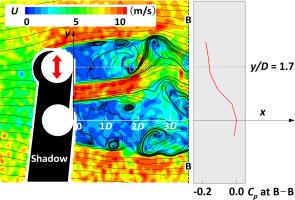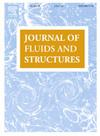Stably biased gap flow between two flapping and stationary short cantilevers in close proximity
IF 3.5
2区 工程技术
Q1 ENGINEERING, MECHANICAL
引用次数: 0
Abstract
Contrary to previously known physics about fluid motion around two side-by-side circular cylinders, this study has demonstrated stably biased gap flow when excited by a flapping and stationary cantilever pair - the gap flow is only deflected towards the flapping cantilever (without switching). Mechanisms for this behavior were presented in this study. To this end, flow visualization and spectral analysis of time-resolved data from hot-wire anemometers and the piezoelectric mount of a flapping cantilever were carried out. Furthermore, particle image velocimetry was conducted to map instantaneous and time-averaged velocity and vorticity fields. During measurements, a center-to-center spacing normalized by cantilever diameter (T/D, pitch ratio) was systematically varied in the Reynolds number range of 1800 ≤ ReD ≤ 13,000. We demonstrated that the Kelvin-Helmholtz (K-H) instability of shear layers separated from the flappable cantilever was intensified due to flapping, consequently inciting the earlier onset of Kármán vortices (evolved from K-H vortices) than those behind the stationary cantilever. Thereafter, an earlier velocity recovery developed, generating a transverse pressure gradient towards the flapping cantilever and subsequent upstream penetration (i.e., potential effect). The gap flow then became stably pushed towards the flapping cantilever.

两个拍动和固定短悬臂梁之间的稳定偏置间隙流
与先前已知的围绕两个并排的圆柱体的流体运动的物理学相反,这项研究已经证明了当被扑动和静止的悬臂对激发时,稳定的偏置间隙流-间隙流仅向扑动悬臂偏转(没有切换)。本研究提出了这种行为的机制。为此,对热线风速计和扑动悬臂的压电支架的时间分辨数据进行了流动可视化和频谱分析。此外,采用粒子图像测速技术绘制瞬时场和时均速度场和涡度场。在测量过程中,通过悬臂直径(T/D,节距比)归一化的中心间距在1800≤ReD≤13,000的雷诺数范围内系统地变化。我们证明了从可扑动悬臂中分离出来的剪切层的开尔文-亥姆霍兹(K-H)不稳定性由于扑动而加剧,从而激发Kármán涡旋(从K-H涡旋演变而来)比静止悬臂后的涡旋更早开始。随后,一个较早的速度恢复发展,产生一个横向压力梯度,指向扑翼悬臂和随后的上游穿透(即潜在效应)。间隙流被稳定地推向扑翼悬臂梁。
本文章由计算机程序翻译,如有差异,请以英文原文为准。
求助全文
约1分钟内获得全文
求助全文
来源期刊

Journal of Fluids and Structures
工程技术-工程:机械
CiteScore
6.90
自引率
8.30%
发文量
173
审稿时长
65 days
期刊介绍:
The Journal of Fluids and Structures serves as a focal point and a forum for the exchange of ideas, for the many kinds of specialists and practitioners concerned with fluid–structure interactions and the dynamics of systems related thereto, in any field. One of its aims is to foster the cross–fertilization of ideas, methods and techniques in the various disciplines involved.
The journal publishes papers that present original and significant contributions on all aspects of the mechanical interactions between fluids and solids, regardless of scale.
 求助内容:
求助内容: 应助结果提醒方式:
应助结果提醒方式:


